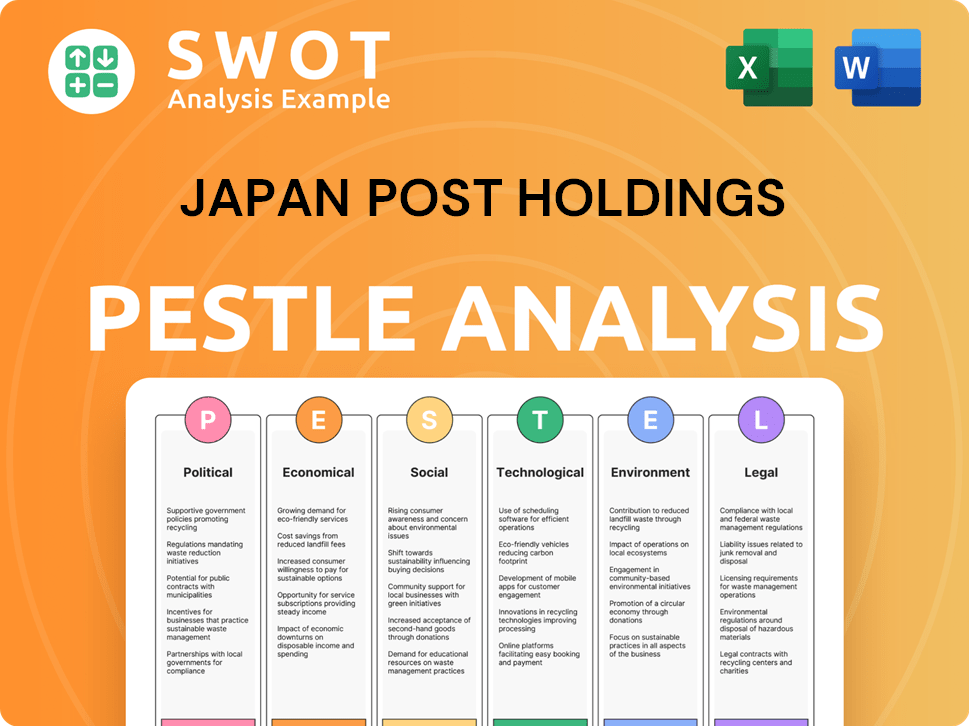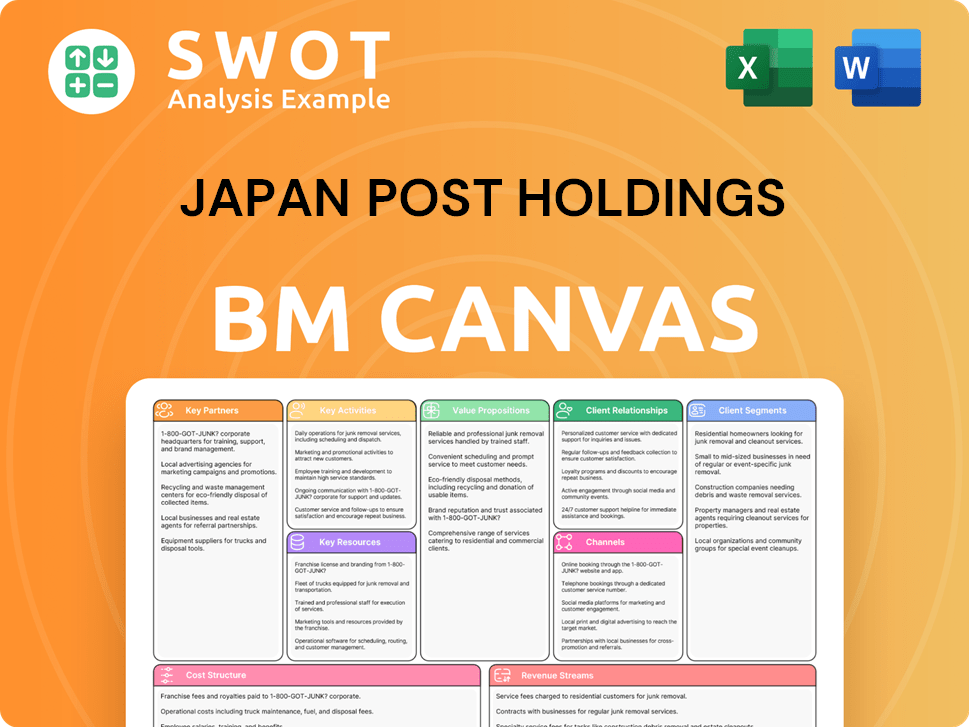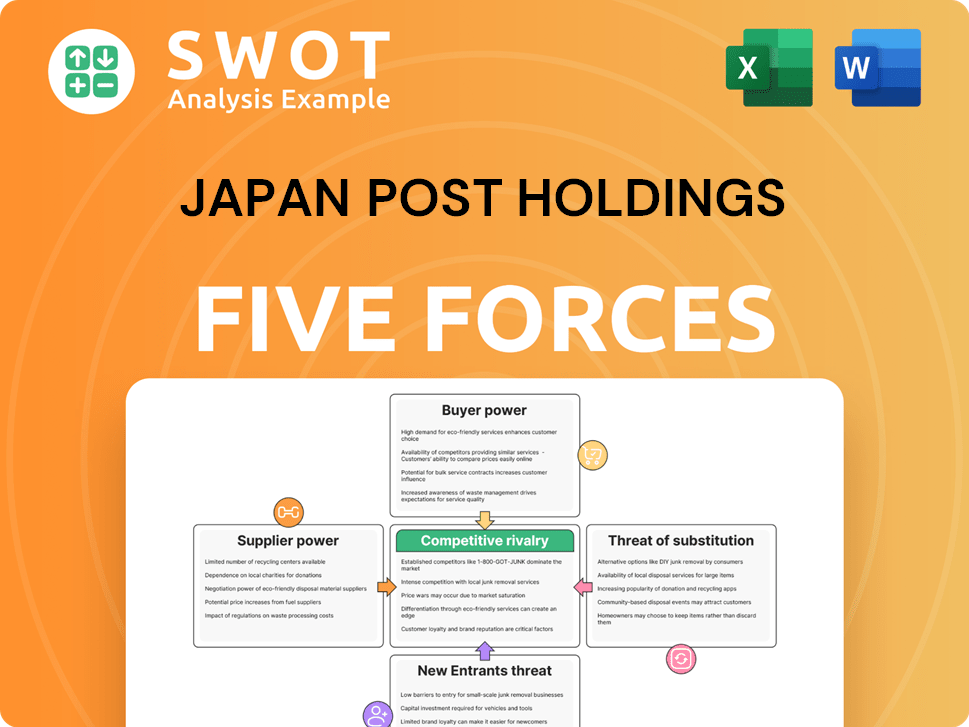Japan Post Holdings Bundle
Who Really Owns Japan Post Holdings?
Understanding the ownership structure of a major corporation like Japan Post Holdings is crucial for investors and analysts alike. The company's journey from a state-owned entity to a publicly traded conglomerate is a fascinating case study in privatization. This exploration will unravel the complexities of Japan Post Holdings SWOT Analysis, revealing the key players and influences shaping its future.

The Japan Post Group's evolution, marked by its IPO and subsequent shifts in shareholding, offers valuable insights into the Japanese postal service and its integration into the global financial landscape. From the government's persistent stake to the influence of institutional investors, the dynamics of Japan Post ownership are constantly evolving. This analysis will examine who controls Japan Post Holdings, its shareholding structure, and the impact of these factors on its strategic direction and financial performance, including annual revenue and its history.
Who Founded Japan Post Holdings?
The establishment of Japan Post Holdings differs from the typical founding of a company, as it emerged from a government-led privatization initiative. The original entity, Japan Post (Nippon Yūsei Kōsha), was created on April 1, 2003, succeeding the Postal Services Agency. The primary objective, championed by Prime Minister Junichiro Koizumi, was to fully privatize the postal service.
The privatization plan, formalized through legislation in 2005, led to the division of Japan Post into four distinct companies under a holding company structure. These included Japan Post Service, Japan Post Network, Japan Post Bank, and Japan Post Insurance. Japan Post Holdings Co., Ltd. was incorporated on January 23, 2006, and officially took over the functions of Japan Post on October 1, 2007, serving as a state-owned holding company for these entities. The initial strategy involved a phased sell-off of shares through 2017.
The early ownership structure was entirely government-controlled, with a plan for gradual privatization that was later modified to ensure continued government influence. The initial public offering (IPO) for Japan Post companies was halted in 2009 by the Democratic Party of Japan. By 2012, the government decided to maintain indefinite control of Japan Post Holdings, retaining a minimum of one-third of the shares, which removed the targets for selling shares in the banking and insurance units.
Japan Post Holdings was not founded by entrepreneurs but through a government-led privatization.
The initial structure involved splitting Japan Post into four separate companies under a holding company.
The initial plan was for a phased sell-off of shares, with the government retaining a portion.
Political shifts altered the privatization trajectory, with the government maintaining control.
The government aimed to retain at least one-third of the shares of Japan Post Holdings.
Japan Post Holdings has several subsidiaries, including banking and insurance units.
The initial ownership of Japan Post Holdings was entirely government-controlled, with a phased privatization plan that was subsequently modified to ensure continued government influence. The government's strategic decisions significantly shaped the Growth Strategy of Japan Post Holdings. As of 2024, the Japanese government still holds a significant stake in Japan Post Holdings, ensuring its influence over the company's operations. The government's control is maintained through its shareholding, which includes a minimum of one-third of the shares, as stipulated by the revised privatization plan. This ownership structure allows the government to influence major decisions and strategic directions of the Japan Post Group. Further details on the company's financial performance and shareholding structure can be found in the Japan Post Holdings financial reports.
Japan Post Holdings SWOT Analysis
- Complete SWOT Breakdown
- Fully Customizable
- Editable in Excel & Word
- Professional Formatting
- Investor-Ready Format

How Has Japan Post Holdings’s Ownership Changed Over Time?
The ownership structure of Japan Post Holdings has evolved significantly since its inception. A key milestone was the 'triple IPO' on November 4, 2015. This initial public offering offered approximately 10% of the shares in Japan Post Holdings, Japan Post Bank, and Japan Post Insurance on the Tokyo Stock Exchange. This IPO raised roughly ¥1.4 trillion ($12.5 billion), representing one of the largest IPOs at the time. The shares were priced at ¥1,400 each, valuing the company at about ¥1.3 trillion ($11.7 billion) upon listing.
Despite privatization efforts, the Japanese government has remained the largest shareholder. This has influenced the company's strategy and governance significantly. The government's stake has gradually decreased, but it still holds a considerable influence. As of June 30, 2024, the Government of Japan held 35.98% of Japan Post Holdings by law, indicating a substantial say in the company's management. To understand more about the company's strategic direction, you can read about the Growth Strategy of Japan Post Holdings.
| Shareholder Type (as of March 31, 2025) | Percentage of Shares Held | Notes |
|---|---|---|
| Government of Japan | 35.98% | Largest shareholder |
| Financial Institutions | 14.16% | Includes major banks and investment firms |
| Foreign Corporations | 17.54% | Significant international investment |
| Individual Investors and Others | 26.51% | Diverse group of shareholders |
Changes in ownership have directly impacted the company's strategy. Japan Post Holdings plans to reduce its stake in Japan Post Bank to below 50%, specifically to 49.9% from 61.5% as of February 2025. This move aims to provide the bank with greater operational flexibility and ease regulatory constraints. This strategic shift is also intended to enhance free-float shares and attract more active investors, supporting Japan's corporate governance reforms.
The Japanese government remains the primary shareholder of Japan Post Holdings, despite privatization. The company's ownership structure includes a mix of institutional and individual investors.
- The government held 35.98% of shares as of June 30, 2024.
- Financial institutions held 14.16% of shares as of March 31, 2025.
- The company is working to reduce its stake in Japan Post Bank to enhance operational flexibility.
Japan Post Holdings PESTLE Analysis
- Covers All 6 PESTLE Categories
- No Research Needed – Save Hours of Work
- Built by Experts, Trusted by Consultants
- Instant Download, Ready to Use
- 100% Editable, Fully Customizable

Who Sits on Japan Post Holdings’s Board?
As of April 1, 2025, the Board of Directors of Japan Post Holdings Co., Ltd. includes both executive and independent directors. Hiroya Masuda serves as the Director and Representative Executive Officer, President & CEO. Atsushi Iizuka is the Director and Representative Executive Officer, Senior Executive Vice President. Other directors include Tetsuya Senda, Kunio Tanigaki, and Takayuki Kasama.
The board also features several independent outside directors, such as Yayoi Ito, Takako Suwa, Noriko Shiono, Miyoko Kimura, Miharu Koezuka, Tsuyoshi Okamoto, Makoto Kaiami, Kosei Shindo, and Hiroshi Oeda. The presence of independent directors is crucial for corporate governance, providing external oversight and representing broader shareholder interests. For a deeper understanding of the company's background, you can refer to the Brief History of Japan Post Holdings.
| Board Member | Title | Role |
|---|---|---|
| Hiroya Masuda | Director | Representative Executive Officer, President & CEO |
| Atsushi Iizuka | Director | Representative Executive Officer, Senior Executive Vice President |
| Yayoi Ito | Outside Director | Independent Oversight |
The voting structure of Japan Post Holdings generally operates on a one-share-one-vote basis for common stock. As of March 31, 2025, the total number of issued shares was 3,206,240,300, with 632,264 shareholders. However, the Japanese government, through the Ministry of Finance, holds a substantial 35.98% of the shares as of March 31, 2025, giving it considerable influence and outsized control. This significant government ownership effectively grants it considerable sway over major corporate decisions. This is a key aspect of Japan Post ownership.
The Board of Directors includes both executive and independent members, ensuring a balance of operational expertise and external oversight. The Japanese government's significant shareholding, at nearly 36%, gives it considerable influence over the company. Recent governance issues highlight the importance of strong oversight within the Japan Post Group.
- The board structure includes executive and independent directors.
- The Japanese government is the largest shareholder.
- Governance controversies have highlighted the need for strong oversight.
- The company is undergoing strategic moves, such as reducing its stake in financial subsidiaries.
Japan Post Holdings Business Model Canvas
- Complete 9-Block Business Model Canvas
- Effortlessly Communicate Your Business Strategy
- Investor-Ready BMC Format
- 100% Editable and Customizable
- Clear and Structured Layout

What Recent Changes Have Shaped Japan Post Holdings’s Ownership Landscape?
Over the last few years, Japan Post Holdings has been actively reshaping its structure and ownership. A significant move in early 2025 involved selling a substantial stake in Japan Post Bank, reducing its ownership below 50%. This strategic sale, completed in March 2025, raised approximately ¥592 billion ($4 billion), decreasing Japan Post Holdings' stake to 49.9%. This change aims to provide Japan Post Bank with greater operational flexibility and address regulatory requirements.
In May 2025, Japan Post Holdings announced a substantial share repurchase program. The company plans to buy back up to 250 million shares, representing 8.41% of its outstanding stock, for ¥250 billion. This initiative, set to conclude on March 31, 2026, is designed to enhance shareholder value and improve capital efficiency. Furthermore, the company had already executed share repurchases totaling ¥350 billion in the fiscal year that ended on March 31, 2025. These actions reflect a commitment to optimizing the capital structure and improving returns.
| Key Development | Details | Financial Impact |
|---|---|---|
| Japan Post Bank Stake Sale | Reduced ownership to below 50% | Raised ¥592 billion ($4 billion) |
| Share Repurchase Program | Buyback of up to 250 million shares | ¥250 billion allocated |
| Acquisition of Tonami Holdings | Completed through a tender offer | US$619 million |
Strategic investments and acquisitions also play a role in the evolving ownership landscape. For example, in March 2021, Japan Post Holdings invested ¥150 billion (US$1.38 billion) in internet conglomerate Rakuten. More recently, in April 2025, the company finalized the acquisition of Tonami Holdings for US$619 million. These moves, along with the ongoing privatization process, indicate a shift towards a more diversified and market-driven structure for the Japan Post Group.
Japan Post Holdings is focused on enhancing shareholder value through share buybacks and strategic investments. The recent share repurchase program and the acquisition of Tonami Holdings demonstrate this commitment.
The government remains a significant shareholder, but its stake is gradually decreasing. Institutional and individual investors are playing a larger role in the transformation of Japan Post's ownership.
The company is actively optimizing its capital structure and enhancing shareholder returns. These initiatives are a key part of the privatization efforts and ongoing corporate governance reforms.
Industry trends like increased institutional ownership are influencing Japan Post Holdings. The company is adapting to these changes as it continues its privatization journey.
Japan Post Holdings Porter's Five Forces Analysis
- Covers All 5 Competitive Forces in Detail
- Structured for Consultants, Students, and Founders
- 100% Editable in Microsoft Word & Excel
- Instant Digital Download – Use Immediately
- Compatible with Mac & PC – Fully Unlocked

Related Blogs
- What are Mission Vision & Core Values of Japan Post Holdings Company?
- What is Competitive Landscape of Japan Post Holdings Company?
- What is Growth Strategy and Future Prospects of Japan Post Holdings Company?
- How Does Japan Post Holdings Company Work?
- What is Sales and Marketing Strategy of Japan Post Holdings Company?
- What is Brief History of Japan Post Holdings Company?
- What is Customer Demographics and Target Market of Japan Post Holdings Company?
Disclaimer
All information, articles, and product details provided on this website are for general informational and educational purposes only. We do not claim any ownership over, nor do we intend to infringe upon, any trademarks, copyrights, logos, brand names, or other intellectual property mentioned or depicted on this site. Such intellectual property remains the property of its respective owners, and any references here are made solely for identification or informational purposes, without implying any affiliation, endorsement, or partnership.
We make no representations or warranties, express or implied, regarding the accuracy, completeness, or suitability of any content or products presented. Nothing on this website should be construed as legal, tax, investment, financial, medical, or other professional advice. In addition, no part of this site—including articles or product references—constitutes a solicitation, recommendation, endorsement, advertisement, or offer to buy or sell any securities, franchises, or other financial instruments, particularly in jurisdictions where such activity would be unlawful.
All content is of a general nature and may not address the specific circumstances of any individual or entity. It is not a substitute for professional advice or services. Any actions you take based on the information provided here are strictly at your own risk. You accept full responsibility for any decisions or outcomes arising from your use of this website and agree to release us from any liability in connection with your use of, or reliance upon, the content or products found herein.